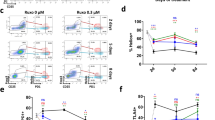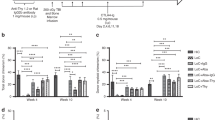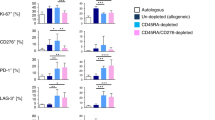Abstract
Graft-versus-host-disease (GVHD) is the most common cause of poor outcome after allogeneic stem cell transplantation (SCT). Of late, exploitation of FOXP3+ regulatory T-cell (TREG) function is emerging as a promising strategy in suppression of GVHD, while preserving graft-versus-leukemia (GVL). Cyclosporine and rapamycin reduce the expansion of effector T cells by blocking interleukin (IL)-2, but signaling by IL-2 is pivotal for TREG homeostasis. The resolution of GVHD is critically dependent on thymus-dependent reconstitution of the immunoregulatory system. Thus, there has been concern about the impact of blocking IL-2 signaling by immunosuppressive agents on TREG homeostasis. Here we demonstrate in a mouse model that in contrast to rapamycin, cyclosporine compromises not only the thymic generation of CD4+CD25+FoxP3+ T cells but also their homeostatic behavior in peripheral immune compartments. Treatment with cyclosporine resulted in a sharp reduction of peripheral CD25+FoxP3+ T cells in all immune compartments studied. Prolonged rapamycin treatment allowed for thymic generation of CD4+FoxP3+ T cells, whereas treatment with cyclosporine led to a reduced generation of these cells. In conclusion, cyclosporine and rapamycin differentially affect homeostasis of CD4+FoxP3+ TREG in vivo. As peripheral tolerance induction is a prerequisite for successful treatment outcome after allogeneic SCT, these findings are of potential clinical relevance.
This is a preview of subscription content, access via your institution
Access options
Subscribe to this journal
Receive 12 print issues and online access
$259.00 per year
only $21.58 per issue
Buy this article
- Purchase on Springer Link
- Instant access to full article PDF
Prices may be subject to local taxes which are calculated during checkout




Similar content being viewed by others
References
Couriel DR, Saliba R, Escalon MP, Hsu Y, Ghosh S, Ippoliti C et al. Sirolimus in combination with tacrolimus and corticosteroids for the treatment of resistant chronic graft-versus-host disease. Br J Haematol 2005; 130: 409–417.
Johnston LJ, Brown J, Shizuru JA, Stockerl-Goldstein KE, Stuart MJ, Blume KG et al. Rapamycin (sirolimus) for treatment of chronic graft-versus-host disease. Biol Blood Marrow Transplant 2005; 11: 47–55.
Antin JH, Kim HT, Cutler C, Ho VT, Lee SJ, Miklos DB et al. Sirolimus, tacrolimus, and low-dose methotrexate for graft-versus-host disease prophylaxis in mismatched related donor or unrelated donor transplantation. Blood 2003; 102: 1601–1605.
Edinger M, Hoffmann P, Ermann J, Drago K, Fathman CG, Strober S et al. CD4+CD25+ regulatory T cells preserve graft-versus-tumor activity while inhibiting graft-versus-host disease after bone marrow transplantation. Nat Med 2003; 9: 1144–1150.
Joffre O, van Meerwijk JP . CD4(+)CD25(+) regulatory T lymphocytes in bone marrow transplantation. Semin Immunol 2006; 18: 128–135.
Cohen JL, Trenado A, Vasey D, Klatzmann D, Salomon BL . CD4(+)CD25(+) immunoregulatory T Cells: new therapeutics for graft-versus-host disease. J Exp Med 2002; 196: 401–406.
Fontenot JD, Rasmussen JP, Gavin MA, Rudensky AY . A function for interleukin 2 in Foxp3-expressing regulatory T cells. Nat Immunol 2005; 6: 1142–1151.
D'Cruz LM, Klein L . Development and function of agonist-induced CD25+Foxp3+ regulatory T cells in the absence of interleukin 2 signaling. Nat Immunol 2005; 6: 1152–1159.
Setoguchi R, Hori S, Takahashi T, Sakaguchi S . Homeostatic maintenance of natural Foxp3(+) CD25(+) CD4(+) regulatory T cells by interleukin (IL)-2 and induction of autoimmune disease by IL-2 neutralization. J Exp Med 2005; 201: 723–735.
Fontenot JD, Gavin MA, Rudensky AY . Foxp3 programs the development and function of CD4+CD25+ regulatory T cells. Nat Immunol 2003; 4: 330–336.
Watanabe N, Wang YH, Lee HK, Ito T, Wang YH, Cao W et al. Hassall's corpuscles instruct dendritic cells to induce CD4+CD25+ regulatory T cells in human thymus. Nature 2005; 436: 1181–1185.
Sakaguchi S, Sakaguchi N . Regulatory T cells in immunologic self-tolerance and autoimmune disease. Int Rev Immunol 2005; 24: 211–226.
Matsuda S, Koyasu S . Mechanisms of action of cyclosporine. Immunopharmacology 2000; 47: 119–125.
Bierer BE, Mattila PS, Standaert RF, Herzenberg LA, Burakoff SJ, Crabtree G et al. Two distinct signal transmission pathways in T lymphocytes are inhibited by complexes formed between an immunophilin and either FK506 or rapamycin. Proc Natl Acad Sci USA 1990; 87: 9231–9235.
Abraham RT, Wiederrecht GJ . Immunopharmacology of rapamycin. Annu Rev Immunol 1996; 14: 483–510.
Chung J, Kuo CJ, Crabtree GR, Blenis J . Rapamycin-FKBP specifically blocks growth-dependent activation of and signaling by the 70 kd S6 protein kinases. Cell 1992; 69: 1227–1236.
Corry RJ, Winn HJ, Russell PS . Primarily vascularized allografts of hearts in mice. The role of H-2D, H-2K, and non-H-2 antigens in rejection. Transplantation 1973; 16: 343–350.
Willerford DM, Chen J, Ferry JA, Davidson L, Ma A, Alt FW . Interleukin-2 receptor alpha chain regulates the size and content of the peripheral lymphoid compartment. Immunity 1995; 3: 521–530.
Siegel JP, Sharon M, Smith PL, Leonard WJ . The IL-2 receptor beta chain (p70): role in mediating signals for LAK, NK, and proliferative activities. Science 1987; 238: 75–78.
Homma M, Damoiseaux JG, Breda Vriesman PJ . Differential effects of cyclosporin-A and rapamycin on in vivo thymocyte maturation. Transplant Proc 1997; 29: 1743–1744.
Hsieh CS, Zheng Y, Liang Y, Fontenot JD, Rudensky AY . An intersection between the self-reactive regulatory and nonregulatory T cell receptor repertoires. Nat Immunol 2006; 7: 401–410.
Germain RN . T cell development and the CD4-CD8 lineage decision. Nat Rev Immunol 2002; 2: 309–322.
Sakaguchi S . Naturally arising CD4+ regulatory T cells for immunologic self-tolerance and negative control of immune responses. Annu Rev Immunol 2004; 22: 531–562.
Fisson S, Darrasse-Jeze G, Litvinova E, Septier F, Klatzmann D, Liblau R et al. Continuous activation of autoreactive CD4+ CD25+ regulatory T cells in the steady state. J Exp Med 2003; 198: 737–746.
Damoiseaux JG, Beijleveld LJ, Breda Vriesman PJ . Multiple effects of cyclosporin A on the thymus in relation to T cell development and autoimmunity. Clin Immunol Immunopathol 1997; 82: 197–202.
Fontenot JD, Rudensky AY . A well adapted regulatory contrivance: regulatory T cell development and the forkhead family transcription factor Foxp3. Nat Immunol 2005; 6: 331–337.
Koonpaew S, Shen S, Flowers L, Zhang W . LAT-mediated signaling in CD4+CD25+ regulatory T cell development. J Exp Med 2006; 203: 119–129.
Fontenot JD, Dooley JL, Farr AG, Rudensky AY . Developmental regulation of Foxp3 expression during ontogeny. J Exp Med 2005; 202: 901–906.
Mantel PY, Ouaked N, Ruckert B, Karagiannidis C, Welz R, Blaser K et al. Molecular mechanisms underlying FOXP3 induction in human T cells. J Immunol 2006; 176: 3593–3602.
Damoiseaux JG, Defresne MP, Reutelingsperger CP, Breda Vriesman PJ . Cyclosporin-A differentially affects apoptosis during in vivo rat thymocyte maturation. Scand J Immunol 2002; 56: 353–360.
Zorn E, Kim HT, Lee SJ, Floyd BH, Litsa D, Arumugarajah S et al. Reduced frequency of FOXP3+ CD4+CD25+ regulatory T cells in patients with chronic graft-versus-host disease. Blood 2005; 106: 2903–2911.
Bensinger SJ, Walsh PT, Zhang J, Carroll M, Parsons R, Rathmell JC et al. Distinct IL-2 receptor signaling pattern in CD4+CD25+ regulatory T cells. J Immunol 2004; 172: 5287–5296.
Damoiseaux JG, Breda Vriesman PJ . Cyclosporin A-induced autoimmunity: the result of defective de novo T cell development. Folia Biol (Praha) 1998; 44: 1–9.
Wu DY, Goldschneider I . Cyclosporin A-induced autologous graft-versus-host disease: a prototypical model of autoimmunity and active (dominant) tolerance coordinately induced by recent thymic emigrants. J Immunol 1999; 162: 6926–6933.
Li Y, Li XC, Zheng XX, Wells AD, Turka LA, Strom TB . Blocking both signal 1 and signal 2 of T cell activation prevents apoptosis of alloreactive T cells and induction of peripheral allograft tolerance. Nat Med 1999; 5: 1298–1302.
Blaha P, Bigenzahn S, Koporc Z, Schmid M, Langer F, Selzer E et al. The influence of immunosuppressive drugs on tolerance induction through bone marrow transplantation with costimulation blockade. Blood 2003; 101: 2886–2893.
Smiley ST, Csizmadia V, Gao W, Turka LA, Hancock WW . Differential effects of cyclosporine A, methylprednisolone, mycophenolate, and rapamycin on CD154 induction and requirement for NFkappaB: implications for tolerance induction. Transplantation 2000; 70: 415–419.
Sakaguchi S, Sakaguchi N . Organ-specific autoimmune disease induced in mice by elimination of T cell subsets. V. Neonatal administration of cyclosporin A causes autoimmune disease. J Immunol 1989; 142: 471–480.
Zeiser RS, Nguyen VH, Beilhack A, Buess M, Schulz S, Baker J et al. Inhibition of CD4+CD25+ regulatory T cell function by calcineurin dependent interleukin-2 production. Blood 2006; 108: 390–399.
Wu DY, Goldschneider I . Tolerance to cyclosporin A-induced autologous graft-versus-host disease is mediated by a CD4+CD25+ subset of recent thymic emigrants. J Immunol 2001; 166: 7158–7164.
Zheng XX, Sanchez-Fueyo A, Domenig C, Strom TB . The balance of deletion and regulation in allograft tolerance. Immunol Rev 2003; 196: 75–84.
Rezvani K, Mielke S, Ahmadzadeh M, Kilical Y, Savani BN, Zeilah J et al. High donor FOXP3-positive regulatory T cell (Treg) content is associated with a low risk of GVHD following HLA-matched allogeneic SCT. Blood 2006; 108: 1291–1297.
Miura Y, Thoburn CJ, Bright EC, Phelps ML, Shin T, Matsui EC et al. Association of Foxp3 regulatory gene expression with graft-versus-host disease. Blood 2004; 104: 2187–2193.
Rieger K, Loddenkemper C, Maul J, Fietz T, Wolff D, Terpe H et al. Mucosal FOXP3+ regulatory T cells are numerically deficient in acute and chronic GvHD. Blood 2006; 107: 1717–1723.
Acknowledgements
We acknowledge Dr AV Schattenberg for careful reading of the manuscript. This study was in part supported by the Dutch Kidney Foundation (Grant C02.2004).
Author information
Authors and Affiliations
Corresponding author
Rights and permissions
About this article
Cite this article
Coenen, J., Koenen, H., van Rijssen, E. et al. Rapamycin, not cyclosporine, permits thymic generation and peripheral preservation of CD4+CD25+FoxP3+ T cells. Bone Marrow Transplant 39, 537–545 (2007). https://doi.org/10.1038/sj.bmt.1705628
Received:
Revised:
Accepted:
Published:
Issue Date:
DOI: https://doi.org/10.1038/sj.bmt.1705628
Keywords
This article is cited by
-
Donor HLA mismatch promotes full donor T-cell chimerism in the allogeneic stem cell transplant with reduced-intensity conditioning and post-transplant cyclophosphamide GVHD prophylaxis
Annals of Hematology (2023)
-
Systematic overview of HLA-matched allogeneic hematopoietic cell transplantation with post-transplantation cyclophosphamide
International Journal of Hematology (2022)
-
Selective involution of thymic medulla by cyclosporine A with a decrease of mature thymic epithelia, XCR1+ dendritic cells, and epithelium-free areas containing Foxp3+ thymic regulatory T cells
Histochemistry and Cell Biology (2021)
-
Post-transplant cyclophosphamide use in matched HLA donors: a review of literature and future application
Bone Marrow Transplantation (2020)
-
Calcineurin inhibitor-free GVHD prophylaxis with sirolimus and mycophenolate mofetil combination
Annals of Hematology (2017)



